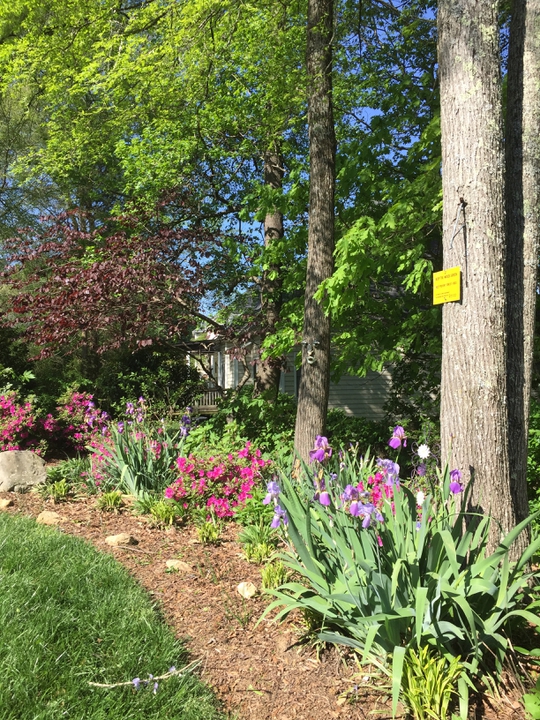April Gardening Tips
go.ncsu.edu/readext?786949
en Español / em Português
El inglés es el idioma de control de esta página. En la medida en que haya algún conflicto entre la traducción al inglés y la traducción, el inglés prevalece.
Al hacer clic en el enlace de traducción se activa un servicio de traducción gratuito para convertir la página al español. Al igual que con cualquier traducción por Internet, la conversión no es sensible al contexto y puede que no traduzca el texto en su significado original. NC State Extension no garantiza la exactitud del texto traducido. Por favor, tenga en cuenta que algunas aplicaciones y/o servicios pueden no funcionar como se espera cuando se traducen.
Português
Inglês é o idioma de controle desta página. Na medida que haja algum conflito entre o texto original em Inglês e a tradução, o Inglês prevalece.
Ao clicar no link de tradução, um serviço gratuito de tradução será ativado para converter a página para o Português. Como em qualquer tradução pela internet, a conversão não é sensivel ao contexto e pode não ocorrer a tradução para o significado orginal. O serviço de Extensão da Carolina do Norte (NC State Extension) não garante a exatidão do texto traduzido. Por favor, observe que algumas funções ou serviços podem não funcionar como esperado após a tradução.
English
English is the controlling language of this page. To the extent there is any conflict between the English text and the translation, English controls.
Clicking on the translation link activates a free translation service to convert the page to Spanish. As with any Internet translation, the conversion is not context-sensitive and may not translate the text to its original meaning. NC State Extension does not guarantee the accuracy of the translated text. Please note that some applications and/or services may not function as expected when translated.
Collapse ▲Spring is in the air and we are ready to see our gardens flourish. April is gardening month so enjoy the spring weather with these timely gardening tips.
Lawn
- Mow your turf at the correct height. Bermuda at 1 to 1.5 inches, St. Augustine at 2 to 3 inches, centipede at 1 to 1.5 inches and zoysia at 1 to 2 inches.
- This is the month to begin fertilizing bermuda and zoysia lawns. Apply nitrogen at a rate of one pound per 1,000 sq. ft. This equals 6 lbs. of 16-4-8 per 1,000 sq. ft.
- Wait until next month to fertilize centipede and St. Augustine lawns.
- Water and fertilize carefully — applying too much water and fertilizer encourages large patch, a destructive fungal disease of lawns.
- If you have not tested soil in the past two years, do so this month before fertilizing to see if additional nutrients or lime are needed. Soil tests are free from April 1st to December 1st.
Trees, Shrubs and Flowers
- Prune spring-flowering plants, such as forsythia, azalea, and spirea immediately after flowering. If you wait until summer or fall to prune, you will remove next season’s flowers.
- If your annuals are flowering vigorously when you plant them, remove at least half of the flowers to give the plants a good start on root, leaf, and flower growth.
- Newly planted trees require regular watering through their first summer. Apply 2-3 gallons per inch of trunk diameter to the root ball at least once a week if it does not rain.
- Newly planted flowers will benefit from liquid fertilization the first few weeks, in addition to slow release fertilizer applied at planting time.
- House plants can be gradually brought outdoors by the middle to end of the month, and any overcrowded plants can be divided and repotted.
Fruits, Vegetables and Herbs
- Prepare garden beds before planting. Till in compost and fertilizer. Add lime ONLY if recommended by soil test reports.
- Set out young pepper and tomato plants in mid- to late April. Wait a few more weeks before setting out cold sensitive eggplant and basil plants.
- Keep an eye out for Colorado potato beetle larvae on potato leaves.
- Direct sow seeds of green beans, limas, field peas, cucumbers, squash, zucchini, winter squash, and sweet corn.
- Harvest garden peas, sugar snaps, and snow peas every few days.
- Thin fruit on apple, peach, and pear trees to increase fruit size, prevent limb breakage and reduce insect/disease problems. Fruit should be thinned when they are about the size of a nickel.
Jessica Strickland is an Agriculture Extension Agent, specializing in horticulture for North Carolina Cooperative Extension in Wayne County.
Learn More!
- Sign up for the Wayne County Extension Gardening email list to receive timely gardening tips.
- Follow us on Facebook and Instagram.
- Visit the North Carolina Extension Gardener Plant Toolbox to discover more plant ideas for your garden.





